LED Bathroom Lights: A Complete Guide for Your Mirror
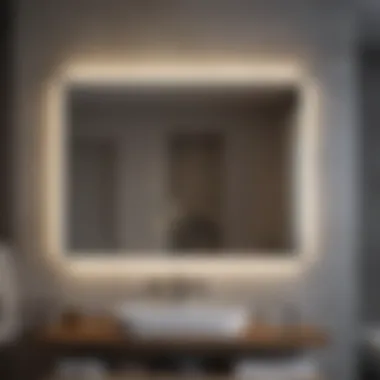
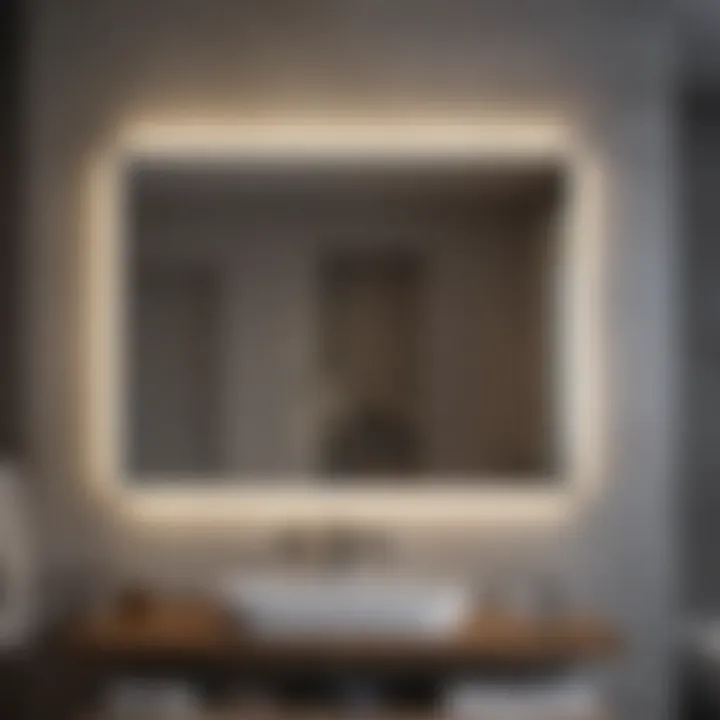
Intro
Lighting in the bathroom, especially around mirrors, can be the unsung hero of home aesthetics. It's more than just seeing your reflection; the right light can transform how you approach daily routines, from applying makeup to grooming. With the growing trend toward minimalistic and functional design, LED lights have taken center stage, offering versatility and efficiency.
Many homeowners often overlook how essential it is to choose suitable lighting, especially for spaces that require precision. Poor lighting can lead to frustration and can negatively affect not only the room's appearance but also the overall mood of the space. With LED lights, homeowners get to choose from a range of brightness levels and color temperatures that can enhance both the practical and visual appeal of the bathroom.
In this guide, we will navigate through current trends, visual ideas, and practical tips for selecting LED lights designed specifically for spaces above mirrors.
Current Trends
Color Palettes
When it comes to color palettes for bathrooms, trending themes gravitate towards soft, soothing tones that evoke a sense of calm and cleanliness. Think gentle hues like pastel blues, pale greens, and warm whites when selecting your bathroom colors. These palettes allow LED lights to shine brilliantly without overwhelming the senses.
LEDs can also be adapted to match these color schemes. For example, a soft white light complements pastel colors while enhancing the brightness of creams and whites. It's essential to consider how different colors interact with light, as warmer tones in the lighting can create an inviting ambience.
Popular Styles
In the realm of design, styles are becoming increasingly varied while still focusing on utility. Popular styles for LED bathroom lights above mirrors today include:
- Sleek and Modern: Think clean lines with integrated LED strips along mirrors for a seamless appearance.
- Industrial: This style incorporates metals and raw materials, often paired with Edison-style bulbs that can add character while positioning above mirrors.
- Vintage Retro: Rounded bulbs and slightly ornate metal fixtures can offer a nostalgic touch, adding charm and comfort to modern spaces.
Homeowners are leaning towards customization as well, mixing and matching styles to create something entirely unique. The flexibility of LED technology allows for innovations like programmable lights that can shift color and intensity based on personal preferences or time of day.
"Good lighting is not just about brightness; it’s about creating a mood and enhancing the beauty of your space."
Visual Ideas
Gallery of Styled Bathrooms
Imagine stepping into a bathroom where the lighting above the mirror casts a soft yet effective glow. Homeowners are showcasing their personal style through carefully selected lighting. A gallery of styled bathrooms reflects not just trends but also innovative possibilities. From spa-like retreats to functional family bathrooms, how the light is arranged and its style can significantly alter perceptions of space.
Before-and-After Transformations
Additionally, there's something powerful about before-and-after transformations involving LED lighting. The right setup can change an uninviting bathroom into a well-lit oasis. These transformations often highlight the importance of lighting and its ability to unveil hidden beauty.
Comparative images often depict dim, harsh lighting versus warm, soft LED illumination. A bright vanity area with properly mounted LED fixtures doesn’t just improve visibility; it enhances overall aesthetics, making spaces feel larger and more inviting.
Exploring these various ideas and trends can inspire homeowners to rethink their bathroom lighting. Making informed decisions about LED fixtures suitable for spaces above mirrors contributes to creating a balance between beauty and functionality, ultimately leading to spaces that enhance daily routines.
Importance of Lighting in Bathrooms
Lighting in bathrooms serves more than just fluffy aesthetics; it is a core component influencing both functionality and mood. Bathrooms can often feel like a sanctuary, a place for unwinding or preparing for the day. Thus, the right lighting is key to enhancing this experience. If a bathroom is too dim, simple tasks like grooming can turn cumbersome, leading to frustration. Conversely, harsh lighting can make a space feel clinical, stripping away any sense of comfort and tranquility.
Role of Lighting in Daily Routines
When we talk about the role of lighting in daily routines, we touch on something that resonates with everyone using the bathroom. The mirror area is particularly significant; it's where the day begins and ends for many. A well-lit space aids in tasks such as shaving, applying makeup, or styling hair. Imagine trying to put on eyeliner under flickering lights – not exactly ideal! Good lighting ensures you can see what you’re doing without squinting or standing uncomfortably close to the mirror.
In practical terms, layering lights is an approach that allows for versatility in brightening up the area. For instance, one might install specific task lighting above the mirror while having some ambient lights surrounding the room. This combination provides flexibility, making it easier to adjust the brightness depending on the task at hand.
Creating Ambiance and Mood
The atmosphere of a bathroom can be swayed dramatically by lighting choices. Flick on the switch and the right bulbs can make it feel like a spa getaway, while poor options could leave it feeling more like an afterthought. Not to mention, when it comes to creating a calming ambiance, color temperature plays a critical role. Warm white lights tend to promote relaxation, while cooler tones tend to energize.
Furthermore, light dimmers are a savvy addition for those who seek control over their environment. As the day winds down and one prepares for sleep, a softer light can signal the body to wind down. Like pouring a warm cup of tea at the end of a long day, the right lighting wraps you in comfort.
Safety Considerations in Bathroom Lighting
In a setting where water and electricity coexist, safety can't be an afterthought. Lighting fixtures must comply with local building codes, particularly regarding moisture ratings. Why take risks when there are options specifically designed for wet conditions? Proper placement is also crucial. For example, overloading a single fixture can create shadows, making it difficult to see clearly – a recipe for accidents, especially when hastily towel-drying. Instead, a well thought-out arrangement allows for even light distribution, reducing potential mishaps.
It's also essential to think about the bulbs' longevity and energy efficiency. Investing in LED lights is not only beneficial in terms of energy savings but offers the added advantage of having a longer lifespan, reducing the chances of needing frequent replacements. Always remember, a bathroom that is both inviting and safe should be the ultimate goal.
"Good lighting can transform a mundane space into a vibrant one, ensuring daily routines are done with ease and comfort."
Ultimately, embracing quality lighting solutions in bathrooms can influence daily life positively, creating an appealing environment while addressing practical needs effectively.
Understanding LED Technology
When it comes to illuminating your bathroom, grasping the fundamentals of LED technology is not just helpful—it's essential. LED, or Light Emitting Diode, represents a significant leap forward in lighting solutions, especially in bathroom environments. Understanding how this technology works will empower homeowners like you to make educated choices regarding your lighting designs above mirrors.
How LED Lights Work
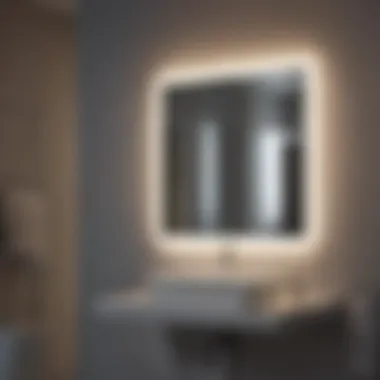
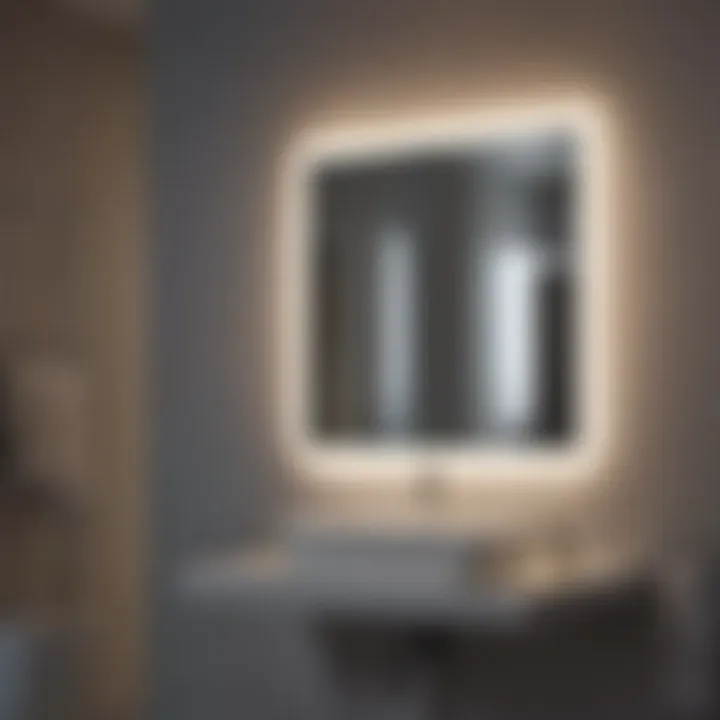
LED lights operate on a simple principle: when electric current flows through a semiconductor material, it emits light. This contrast to traditional incandescent bulbs, where electricity heats a filament until it glows. LEDs are highly efficient; they convert a large portion of the energy they consume directly into light rather than heat. This means they use far less electricity to deliver the same brightness, which can save you a pretty penny on your electricity bill.
To break this down further:
- Structure: LED lights consist of multiple tiny diodes. When these diodes are energized, they emit light across a range of colors based on their chemical composition.
- Lifespan: Unlike traditional bulbs that may last about 1,000 hours, LEDs commonly provide upwards of 25,000 hours of illumination. This longevity can dramatically reduce replacement costs.
- Instant Brightness: Turn an LED on, and it reaches full brightness immediately. No more waiting for a bulb to warm up!
Comparison with Traditional Lighting
When you stack LEDs against their traditional counterparts like incandescent and fluorescent lighting, the advantages become glaringly apparent.
- Energy Consumption: LEDs are vastly more energy-efficient, consuming up to 75% less energy than incandescent lamps. This means less strain on your wallet.
- Heat Production: LEDs generate minimal heat compared to traditional lighting, which can feel like a sauna in a small bathroom space. Less heat signifies a safer environment, reducing the risk of burns or unintentional fires.
- Durability: Traditional bulbs are fragile; drop one, and you can count on a shattered mess. LEDs, on the other hand, are much sturdier, making them suitable for high-traffic areas like bathrooms.
- Light Quality: While some might argue about the warm ambiance of old-school bulbs, LEDs now come in various color temperatures, offering solutions that mimic the cozy tone of traditional lighting.
Environmental Impact of LEDs
Beyond the practical benefits in your home, LED technology also boasts a positive environmental footprint. Since they consume less energy, LEDs can contribute to reductions in greenhouse gas emissions from power plants. It’s a small but meaningful impact you can make right from your bathroom.
- Reduced Waste: With their long lifespan, fewer bulbs end up in landfills, significantly cutting down your waste.
- Mercury-Free: Unlike compact fluorescent lights, LEDs don’t contain mercury or other hazardous materials, making disposal and recycling easier and safer for everyone.
"Choosing LED lighting for your bathroom isn't just an upgrade—it's a step toward a more sustainable home."
In summary, a firm grasp of LED technology arms you with knowledge to select the best lighting for your mirror area, enhancing both functionality and aesthetic appeal while being kind to your pocketbook and the planet.
Benefits of LED Bathroom Lights
When it comes to modern bathroom design, LED lights are not just a fleeting trend; they embody a shift toward smarter, more efficient home lighting solutions. Emphasizing functionality and aesthetic appeal, the benefits of LED bathroom lights are plentiful. From cost savings to diverse stylistic options, these lights can truly enhance the bathroom experience.
Energy Efficiency and Cost Savings
One of the most notable advantages of LEDs is their energy efficiency. Unlike traditional bulbs, which tend to guzzle electricity, LEDs consume significantly less power, making them a financially savvy choice.
"Switching to LEDs can reduce your energy bills by up to 75%, depending on usage!"
In practical terms, if a household replaces its incandescent bulbs with LED lights, it can lead to profound savings over time. Consider this: While a standard 60-watt incandescent bulb burns through 60 watts of power, an equivallent LED bulb only requires about 10 to 12 watts. Over a year, that difference multiplies not just in utility costs but also in the longevity of the bulbs—LEDs commonly last 15,000 hours or more compared to the mere 1,000 hours of traditional bulbs.
Longevity and Durability
LED lights shine bright for a long time, literally. Their lifespan significantly surpasses that of incandescent or fluorescent lights. This durability means fewer replacements, not just saving money but time and effort. Additionally, LEDs are typically more resistant to shattering and damage owing to their solid-state components. Coupled with the ability to function effectively in varying temperatures, this makes them particularly suited for the humid bathroom environment.
Another aspect to appreciate is their ability to maintain brightness and color without a drop-off in quality over time. You won’t experience the occasional flickering or dimming that often signals the end of a more traditional light source's life. Instead, they offer consistent illumination day in and day out.
Versatility in Design
When it comes to choosing lighting for above the mirror in bathrooms, LEDs can serve countless design needs. Available in a variety of shapes, sizes, and styles, they give homeowners a blank canvas to work with. Whether you're leaning towards a sleek, minimalist aesthetic or a more intricate vintage look, there's an LED solution that fits.
- Fixture Options: Wall-mounted sconces, recessed lighting, or pendant fixtures—all can be LED-based.
- Color and Brightness: Many LED options offer adjustable brightness settings, and color options range from warm, comforting hues to bright, vibrant whites.
Another advantage is their ability to create various lighting effects, from direct task lighting that helps with morning routines to soft ambient light for unwinding. Ultimately, the versatility in design helps bring a personal touch to the bathroom, allowing each homeowner to reflect their individual style without compromising on functionality.
Choosing the Right LED Lights for Your Bathroom
When it comes to bathroom lighting, choosing the right LED lights is a pivotal step. It’s not merely about flipping a switch; it’s about creating an atmosphere and enhancing functionality. Lighting should align with how you use the space—whether it’s for a quick morning routine or a relaxing soak at the end of the day.
Selecting the correct LED lights can dramatically influence the overall vibe of your bathroom. You’ll want to take into account brightness levels, color temperature, and your personal style to ensure a perfect blend of aesthetics and utility.
Determining Brightness Levels
Determining brightness levels is foundational. What good is a great design if you can't see what's in front of you? Light intensity can affect how you groom or perform daily tasks. On average, 100 to 150 lumens per square foot is a common guideline for bathroom use. A more dimly lit atmosphere might make your space feel cozy, but for daily routines, you might want a bit more umph. Consider layering your lighting; use bright, concentrated lights for tasks above mirrors and softer lights for a relaxing bath vibe.
Selecting Color Temperature
Color temperature is another significant factor in LED lighting choices.
Warm White vs. Cool White
Warm white lights generally emit a yellowish tone, while cool white leans toward a bluish hue. Warm white is often favored in bathrooms for its soft and inviting feel, giving a more comfortable appearance to skin tones while applying makeup or checking your reflection. Conversely, cool white enhances crispness and clarity, which can be beneficial for tasks requiring precision. However, too much cool white can feel harsher, so balance is key.
"Always aim for a light that complements your skin tones and the overall color scheme of your bathroom."
Impact on écor
The color temperature also plays a vital role in how colors in your bathroom look. For instance, if your bathroom has earthy tones, warm light can enhance those shades beautifully. Meanwhile, cool lighting can clash with warm color palettes, which could potentially make your space feel unwelcoming. Evaluate your décor style and choose fixtures that will highlight your design choices, avoiding any fixtures that might compete with your existing aesthetic.
Style and Aesthetic Choices
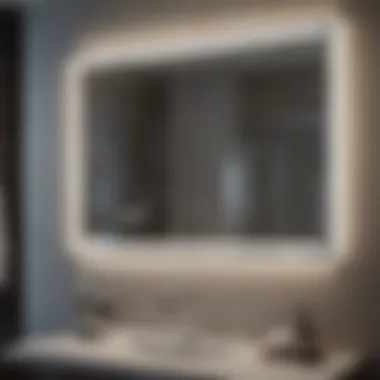
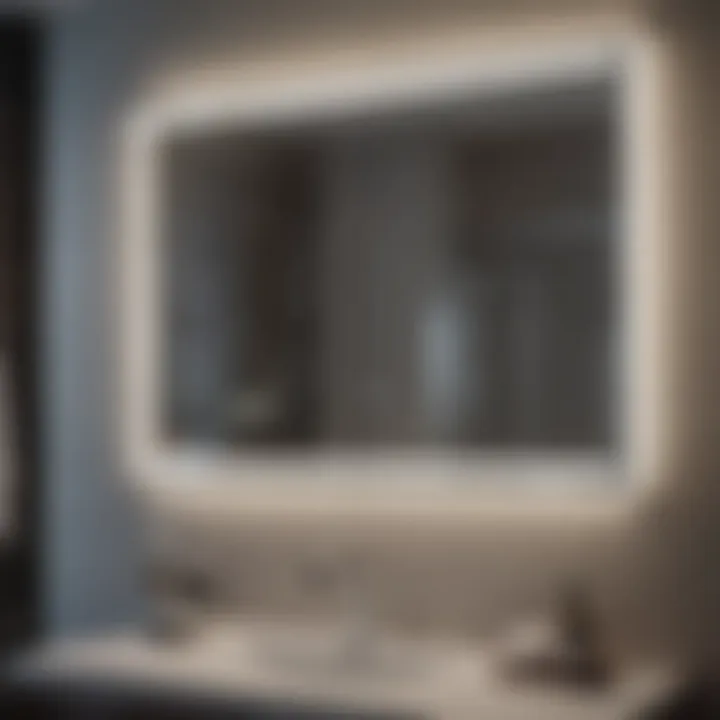
The style of your lighting shouldn’t be an afterthought. Consider the overarching design theme of your bathroom. From ornate fixtures that evoke vintage charm to sleek, modern designs, your LED lights should complement your space rather than contrast it. You might even want to create a focal point with stylish sconces or a contemporary light bar hung directly above the mirror.
- Fixtures: Think about the materials and finishes. Metal and glass can add sophistication, while wood treatments may evoke warmth.
- Shapes: Round mirrors pair well with circular bulb arrangements; sharp square mirrors can benefit from linear light.
By carefully assessing these aspects, you can ensure that your bathroom lighting isn’t just functional but aligns perfectly with what you envision for your personal sanctuary.
Installation Considerations
When it comes to LED bathroom lights over the mirror, installation is a pivotal part of the process that demands attention. The functionality and ambiance of your bathroom space hinge significantly on how these lights are set up. If done correctly, they can illuminate your reflection perfectly, allowing for optimal grooming routines and enhancing the overall look of the bathroom.
Electrical Requirements
Before diving into actual installation, it's crucial to consider the electrical requirements for your LED lights. These lights are typically more energy-efficient than traditional bulbs, but they still require proper voltage and wiring to operate correctly. Ensure your electrical system can handle the new lighting—this might involve checking the wattage of your existing fixtures or even upgrading your circuit.
It’s also important to consider:
- Amp Load Capacity: Make sure the circuit has a sufficient load capacity to support the new lights without tripping.
- Type of Switch: If you're integrating dimmable LED lights, you may need a compatible dimmer switch to avoid flickering or buzzing.
- GFCI Outlets: Since bathrooms are often moist environments, ensuring that all electrical installations comply with safety regulations is essential. Using Ground Fault Circuit Interrupter outlets can prevent electrical shocks, a critical consideration for wet areas.
"Proper electrical setup is not just about aesthetics; it’s about safety first."
Placement Above Mirrors
The placement of LED lights above mirrors is an art that blends functionality with nuance. It’s about creating a balance where light reflects evenly across your face, eliminating shadows and providing the best illumination for tasks such as shaving or applying make-up. Here are a few pointers for optimal placement:
- Height Matters: Position the lights at or slightly above eye level. This prevents harsh shadows from above and ensures light radiance is soft and flattering.
- Width of the Fixture: Ideally, fixtures should be wider than the mirror to prevent dark spots at the edges. A common guideline is having the fixture extend at least 6 inches beyond the mirror’s edge.
- Spacing from the Wall: Ensure that the light sources are spaced adequately from the wall to allow a gentle diffusion of light. A few inches can make a notable difference in how light scatters in the room.
- Consider Multiple Sources: Instead of a single fixture, consider using two lights on either side of the mirror for added depth and evenness in lighting.
These considerations play a critical role in creating a well-lit bathroom, where every detail can be seen.
Hiring Professionals vs. DIY
The question of whether to hire professionals or take on the task yourself often comes down to skill level, comfort with electrical work, and budget constraints. Here’s a breakdown of the pros and cons:
- Hiring Professionals
- DIY
- Expertise: They bring experience and can easily navigate any unforeseen issues during installation.
- Time-Saving: A professional job can typically be done faster, allowing you to enjoy your new setup sooner.
- Warranty: Many professional services offer a warranty on their work, ensuring peace of mind that issues can be resolved without extra cost.
- Cost-Effective: There's significant savings in not paying for labor, which is often substantial in home renovations.
- Personal Satisfaction: Completing a project yourself can offer a sense of accomplishment and mastery over your space.
- Learning Experience: Tackling installations can enhance your skill set for future projects.
Ultimately, the decision lies in evaluating your own comfort with electrical systems against the need for professional assurance and efficiency.
By keeping these installation considerations in mind, you can ensure your LED lights above the mirror are effectively set up to enhance not just functionality but the aesthetic vibe of your bathroom as well.
Maintenance of LED Lights
Maintaining LED lights in your bathroom isn't just a chore; it's a crucial element in ensuring that your lighting stays efficient and long-lasting. When you invest in LED lights, especially those designed for above the mirror, understanding how to care for them can save you money in the long run and keep your bathroom looking its best. By considering specific aspects of maintenance, you can greatly extend the lifespan of your LED fixtures, optimize their performance, and ensure you enjoy a well-lit space that meets your functional needs.
Routine Cleanliness
Keeping your LED lights clean is often overlooked but can make a significant impact on their performance. Dust and grime can accumulate on the surfaces of light fixtures and lenses, reducing brightness and affecting light quality. A few simple steps can maintain their clarity and efficiency.
- Regular Wipe Downs: Use a soft, damp cloth to wipe down the fixtures. Avoid harsh chemicals that can damage the surface. At least once a month is an ideal maintenance routine.
- Check for Obstructions: Look for any items around the fixture that may block light. Sometimes, things like decorative items or even plant leaves can shade your light, diminishing its effectiveness.
- Dust the Bulbs: Be sure to dust the bulbs themselves gently; this can further improve light output. Even a light layer of dust can dim the shine considerably.
Regular maintenance reduces energy bills and enhances the life of your LED lights.
Troubleshooting Common Issues
Issues with LED lights are generally few, but understanding how to troubleshoot them can prevent small problems from spiralling. Here are common issues you might encounter:
- Flickering Lights: This can often be a sign of poor connections, so check all wiring to ensure they're secure. If the problem persists, it may be time to consult with a qualified electrician.
- Cool to the Touch: Unlike traditional bulbs, LEDs are designed to be energy-efficient and may not warm up as much, but if your fixture feels excessively cold, it might indicate a problem with the LED driver.
- Dim Performance: If your lights dim over time, it might be a sign they are nearing the end of their lifespan or that there's a compatibility issue with your dimmer switch, in such a case, consider swapping out for a compatible switch.
When to Replace LED Bulbs
Knowing when to replace your LED bulbs can be a fine art. While LEDs can last for a long time, there are signals that suggest it’s time for a change. Here are some considerations:
- Lifespan Estimates: Most LED bulbs have rated lifespans between 15,000 to 50,000 hours. If you've used your lights consistently, keep an eye on usage to estimate when they might need replacing.
- Color Shift: If you notice a color change in your LED light, from bright white to yellowish shades, it might be time to look for new replacements. This change can indicate degradation.
- Physical Damage: Cracked housing or exposed wiring is a definite red flag. Not only does it compromise the function of the light, but it can also pose safety risks.
Staying proactive with maintenance and replacement will ensure that your bathroom lights are illuminating your space effectively. A little attention goes a long way.
Trends in LED Bathroom Lighting
When choosing LED lighting for bathroom spaces, being aware of current trends can make a significant difference in functionality and aesthetics. Trendy bathroom lighting not only illuminates the area but also enhances the overall design and makes the room feel more inviting. Homeowners are increasingly looking for practicality without giving up on style. Let’s dive into a few important components of modern LED bathroom lighting trends that are gaining traction in recent years.
Minimalist Designs


Minimalism is not just a trend; it's a lifestyle choice for many. In the realm of bathroom lighting, minimalistic designs appeal to those who prefer clean lines and a clutter-free appearance. People are moving away from heavy fixtures that dominate a space toward simpler and subtler options that blend seamlessly with the decor.
- Sleek Fixtures: Think of streamlined shapes in matte finishes or polished metals that don’t compete for attention.
- Focal Points: Positioning a single, elegant light fixture above the mirror can create a streamlined look while still providing necessary illumination.
- Open Space: With fewer bulky items, rooms can feel more spacious and airy, which is particularly desirable in smaller bathrooms.
This style enables homeowners to keep their bathrooms looking chic yet functional, allowing the rest of the area—like tiles or wall colors—to come into play beautifully.
Smart Lighting Features
In an era where technology shapes our daily routines, bathroom lighting is no exemption. Smart lighting solutions add layers to how we interact with our environments. Imagine adjusting the brightness or color of your lights with a simple voice command or a touch of a button!
- Customization: Smart lights allow users to change color temperatures depending on the time of day, aiding in relaxation or alertness.
- App Control: Many products offer smartphone connectivity enabling customization when you’re away from home.
- Scheduling: You can set lights to follow your daily routine, softening at night to create a calming atmosphere.
Incorporating smart lighting not only modernizes a bathroom but also leads to better energy management and adds a convenience factor.
Integrated Lighting Solutions
Integrated lighting is about combining various types of light sources within the same fixture. This trend is gaining momentum due to its efficiency and aesthetic appeal. Instead of relying on external sources of light, integrated solutions can provide direct, diffused, or ambient lighting from the same fixture.
- Versatility: Lighted mirrors that come with built-in LED technology are not just space savers; they also eliminate the need for additional fixtures.
- Energy Efficiency: These integrated solutions often use less energy than traditional setups, making them a more sustainable option.
- General Illumination: With the right design, integrated lighting can distribute illumination evenly, preventing dark spots that can affect your grooming routines.
As a result, integrated lighting can not only help declutter your space but also fulfill various lighting needs seamlessly.
"In modern bathrooms, light is not just a necessity. It’s a statement about the home and the lifestyle of those who inhabit it."
Seeing how trends like minimalism, smart features, and integration work together to form cohesive bathroom lighting choices shows a clear movement towards more thoughtful and designed spaces, suitable for contemporary lifestyles. By embracing these ideas, homeowners can create inviting and functional bathrooms that meet modern standards.
Case Studies: Successful Bathroom Designs
In designing a bathroom that not only serves its primary purpose but also elevates the overall home aesthetic, one must consider many aspects including functionality, style, and lighting. The inclusion of LED lights over mirrors significantly enhances the space's ambiance while also ensuring sufficient illumination for daily routines. By examining successful bathroom designs, homeowners can draw inspiration and practical ideas that are both elegant and efficient.
Transitional Styles
Transitional design is all about blending traditional and contemporary elements. In a bathroom setting, this might manifest through elegant fixtures combined with clean lines and modern materials, creating a space that feels both timeless and fresh. The latest trends show how LED lights can effectively bridge this gap, offering versatility while complementing both classic and modern styles.
Here, a series of small, sleek LED fixtures placed above the mirror can create an unobtrusive yet effective lighting solution that coexists with rich wooden vanities and porcelain sinks.
Homeowners opting for transitional styles often appreciate a warm white lighting temperature. This not only adds a subtle glow that flatters skin tones, but also enhances the wooden textures, creating a cozy feel, perfect for unwinding after a long day.
Consider sharing the following points with your audience:
- Harmonized Elements: Focus on creating balance between differing design styles.
- Color Palette Selection: Aim for neutral tones with one or two accent colors.
- Lighting Shape and Placement: Think about fixtures that draw the eye without overpowering the room.
Contemporary Installations
The contemporary bathroom, on the other hand, places a heavy emphasis on sleekness and simplicity. In such spaces, LED lighting can truly shine. With an array of options available, from integrated lighting solutions to hanging fixtures, the possibilities are nearly endless. For instance, an elongated LED strip can run along the top of a mirror or within a floating vanity, providing both up and down lighting for maximum effect.
These installations not only promote a clean, streamlined look, they also offer practical benefits. A cooler color temperature can be chosen to create a stark contrast against warmer materials, while still providing sufficient brightness for everyday tasks like shaving or applying makeup.
Discuss key considerations:
- Function Meets Aesthetics: Balance practicality with modern design.
- Light Direction: Understand how ambient, task, and accent lighting can transform the space.
- Reflection and Shadows: Contemplate how to avoid unwanted shadows during use.
Historical Influences on Modern Design
Historical influences are vital in understanding current trends in bathroom design. Many contemporary bathrooms channel styles from different eras, resulting in unique spaces that tell a story. For example, the inclusion of vintage fixtures along with modern LED lights can create an intriguing contrast. By placing a vintage mirror with ornate carving against a bold, contemporary backdrop, it invites the use of LED lights to emphasize its features.
Consider looking back at architectural periods like Art Deco or Mid-Century Modern, where lighting played a crucial role in defining the atmosphere. These historical designs still resonate today and can be effectively paired with LEDs without compromising their essence.
Here are some aspects to highlight:
- Diverse Design References: How past eras influence present trends.
- Mixing Materials: Incorporating glass, metal, and ceramics for a harmonious look.
- Light Fixture Selection: Match fixtures to the historical context you wish to reflect.
"By integrating historical elements into modern designs, homeowners not only showcase their personal style but also create a dialog between past and present, enriching the overall narrative of their space."
Finale
When it comes to choosing the right LED bathroom lights above mirrors, it's more than just a visual preference; it's about enhancing the overall functionality and aesthetic of your bathroom. A well-thought-out lighting scheme can transform a standard space into a haven of relaxation and practicality. This article has explored several layers of this topic, from understanding the fundamentals of LED technology to the practicalities of installation and maintenance.
Summarizing Key Insights
Reflecting on the critical points discussed, proper lighting is essential in a bathroom where tasks such as grooming, applying makeup, or simply unwinding in a soothing atmosphere take place. LED lights provide energy efficiency, longevity, and versatility, making them an ideal choice for bathroom settings.
Considerations like brightness levels and color temperatures greatly influence the efficacy of bathroom lighting:
- Brightness Levels: Ideally, lighting should be bright enough to illuminate faces without creating shadows. A combination of task lighting and ambient lighting often works best.
- Color Temperature: Choosing between warm and cool white affects not just visibility but mood. For example, a cool white light can enhance alertness during morning routines, while warmer tones are great for evening unwinding.
The selection process for LED lighting needs careful thought regarding style and placement.
"Good lighting is the difference between a chore and a pleasure."
Your choice of fixtures—be it sleek modern sconces or vintage-inspired designs—can elevate the overall style of your space.
Future Directions for Bathroom Lighting
Looking ahead, the future of bathroom lighting is promising. Increasing integration of technology is already altering how we perceive and implement lighting solutions. Here are a few trends worth noting:
- Smart Lighting Features: Home automation is here to stay. Dimming lights remotely or changing color temperature according to time of day is gaining traction among homeowners.
- Sustainability Focus: More manufacturers are committing to energy-efficient solutions, which means LEDs are evolving to provide even more benefits.
- Custom Solutions: Personalization in lighting design is becoming more common. Customization allows individuals to choose colors and styles that best reflect their personality while fitting within the practical needs of the bathroom.



